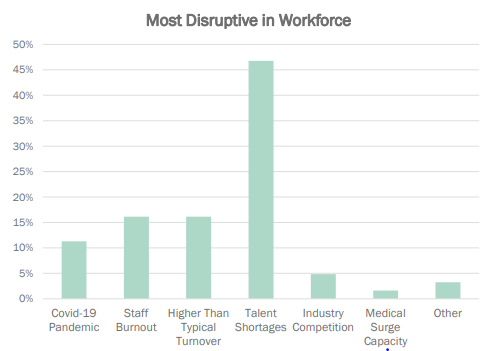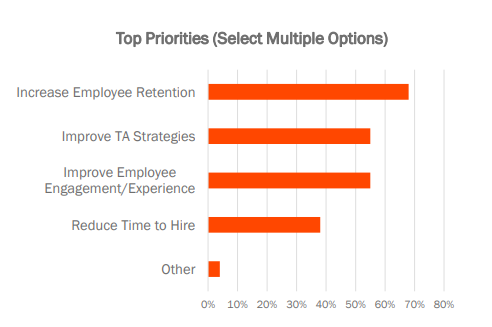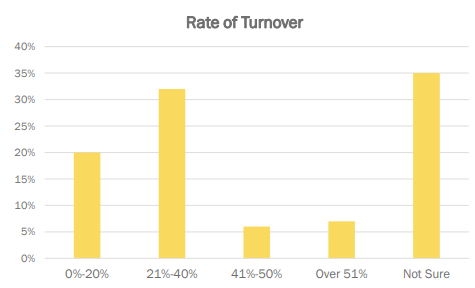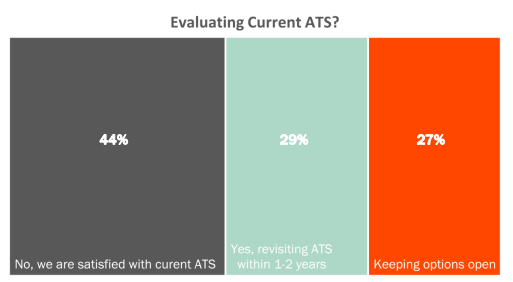November 8th, 2022 | Sterling
The Healthcare Hiring Landscape: Takeaways from Sterling’s Mid-Year Survey

It’s been almost three years since the Covid-19 pandemic began. During this time, healthcare organizations ranging from hospitals and long-term care facilities to medical device companies and healthcare staffing firms were dealt with an array of hiring challenges that are still being felt today.
Sterling’s healthcare background check team has continued to support our clients’ unique needs in response to these challenges. To better understand the current outlook of today’s hiring environment and how our clients are continuing to respond to this, our team conducted a Mid-Year Hiring in Healthcare Survey.
Below are some of the key results from the survey.
1. Talent Shortages Have Been Most Disruptive in the Healthcare Workforce
Unfortunately, the healthcare industry is still struggling to find top talent. Almost half of our survey respondents (47%) indicated the lack of talent as being most disruptive to their workforce. Following that, burnout and higher turnover came in at roughly 16%. We also saw that acute care and post-acute care industries reported talent shortages at a much higher rate compared to life science organizations.

Addressing this topic, we recently published a blog post on strategies for recruiting healthcare talent. A few ways to help grow your talent pool can include:
- Explore hiring contingent workers
- Leverage advanced background screening technology
- Consider second chance hiring
- Recruit internationally
Having a simple and easy application process can also attract more candidates and improve the candidate experience. Are potential bottlenecks in the hiring process hurting your ability to grow your talent pool? Is the hiring process too complicated or too long? Can candidates apply for a role on the go via their mobile devices? In 2021, mobile job applications officially surpassed those submitted on desktop computers with 70% of all applications submitted via mobile devices. Sterling offers candidates a native mobile experience on Candidate Hub making it the best way to ensure a smooth and engaging hiring experience from the initial recruiting process all the way to onboarding new employees.
2. Retaining Employees Remains the Number One Priority
Although improving talent acquisition strategies was listed as a priority for our clients, especially for post-acute care organizations, the majority of our survey respondents shared that increasing their employee retention strategy was their top priority.

Unfortunately, our same survey respondents also indicated that the turnover rate in the healthcare industry continues to remain high, with larger enterprises seeing higher rates than small to mid-size companies.

There are many things that are driving turnover in healthcare, such as industry competition and an increased demand for remote roles. We have seen our clients implement best practices to address these issues, from investing in their employees’ professional growth to offering time to unwind to reduce the risk of burnout.
HR teams can address retention and turnover challenges early by hiring the right candidate. What do we mean by that? Candidates who are better aligned with the organization’s mission and culture are likely to feel more engaged and satisfied in their role. Conducting an accurate background check can also provide teams with the level of detail needed to hire the best talent confidently. Healthcare organizations have their own specific requirements that are more intricate than standard, conventional background screening, so they should consider a healthcare background check partner that offers healthcare expertise and understands the regulatory landscape.
3. Healthcare Organizations are Exploring New ATS Options
Integrating your background checks program into your existing applicant tracking system can simplify your recruiting, tracking, and monitoring. With the need to onboard staff quickly, we were interested to see if our survey respondents were satisfied with their current applicant tracking system (ATS) or if they were considering looking into other options.

Although 44% reported that they were satisfied with their current ATS, almost 30% of respondents, mainly from post-acute care organizations, noted that they intend to review their current ATS within the next 1-2 years.
Integration can enable you to complete background screening with greater efficiency and speed. With the largest number of integrations in the background screening industry, Sterling’s integration partners can help organizations reduce the time to initiate background checks, streamline credentialing verifications, and enable HR teams to make informed hiring decisions.
Conclusion
The demands that have been put on healthcare workers and HR teams have stretched the entire healthcare industry thin. The ongoing efforts of recruiting, onboarding, and retention will continue to be both a priority and a challenge. As healthcare organizations continue to rebuild their workforces, they should review their overall hiring processes and ensure they have the necessary tools and support needed to be successful.
Sterling is not a law firm. This publication is for informational purposes only and nothing contained in it should be construed as legal advice. We expressly disclaim any warranty or responsibility for damages arising out this information. We encourage you to consult with legal counsel regarding your specific needs. We do not undertake any duty to update previously posted materials.

